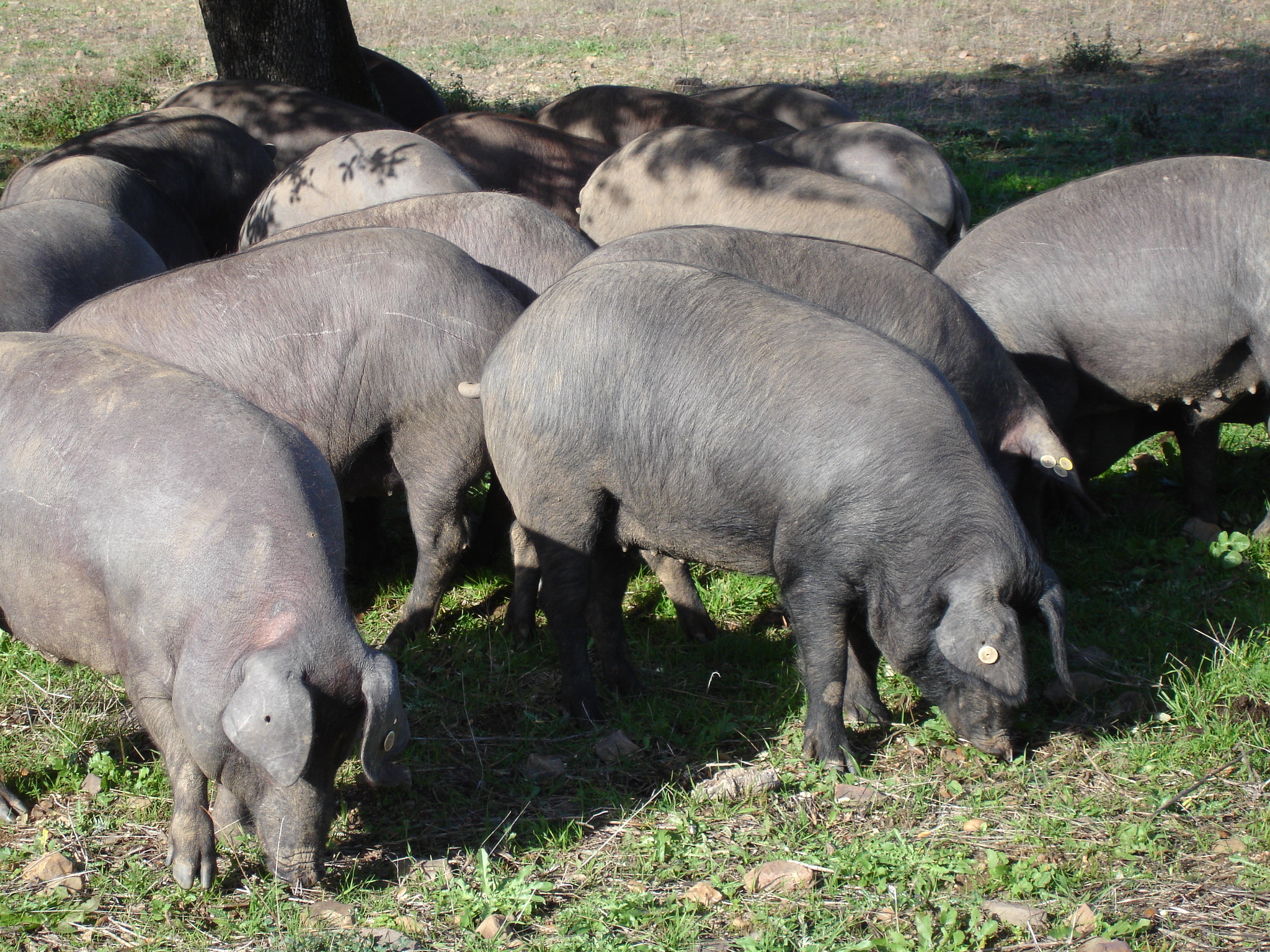- Black Iberian Pig
Taxobox
status = Domesticated
name = Iberian Pig

image_width = 250px
image_caption = Iberian pigs
regnum =Animal ia
phylum = Chordata
classis =Mammal ia
ordo =Artiodactyla
familia =Suidae
genus = "Sus "
species = "S. scrofa"
binomial = "Sus scrofa"
binomial_authority =The Black Iberian Pig (Sus ibericus), also known in Portugal as Alentejano Pig, is a
breed , Mediterraneus, of thedomestic pig ("Sus scrofa domesticus") that is indigenous to theMediterranean area. The Iberian pig, whose unique origin can be traced back to ancient times, is found in herds clustered in the central and southern territory of theIberian Peninsula , inPortugal andSpain .The most commonly accepted theory is that the first pigs were brought to the Iberian Peninsula by the
Phoenicians from the Eastern Mediterranean coast (current dayLebanon ) where they interbred withwild boar s. This cross gave rise to the first Iberian breeds whose origins, in this case, can be traced back to about the year 1000 B.C. The production of Iberian pig is deeply bound to the Mediterranean ecosystem. It is a rare example in the world swine production where the pig contributes so decisively to the preservation of theecosystem . The Iberian breed is currently one of the few examples of a domesticated breed which has adapted to a pastoral setting where the land is particularly rich in natural resources, in this case theholm oak , gall oak andcork oak . [ Lopez-Bote, C J [http://dx.doi.org/10.1016/S0309-1740(98)90036-5 Sustained utilization of the Iberian pig breed] Available online 18 October 2003; Departamento de Produccio´n Animal, Facultad de Veterinaria,Universidad Complutense ,Madrid , Spain ][ [http://www.ibergour.com/en/jamon/jamon_pata_negra.html "Pata Negra" Spanish Jamon Serrano] ] Albeit, the numbers of the Iberian breed were drastically reduced since 1960 due to the outbreak of the
African swine fever , the lowered value ofanimal fat s and the massive introduction of more efficient foreign breeds. In the last few years, this population bottleneck has been reversed and the production of pigs of the Iberian type has increased to satisfy the new demand of top quality meat and cured products. However, the old breed structure, with differentiated varieties locally distributed, has been replaced by a pyramidal structure based on crossbreeding with Duroc. In these circumstances, some ancestral varieties have disappeared, others are endangered or blended, necessitating a new design for programmes of conservation of these genetic resources. [ E Fabuel, E; Barragán, C; Silió, L; Rodríguez, L C and Toro, M A [http://www.nature.com/hdy/journal/v93/n1/full/6800488a.html Analysis of genetic diversity and conservation priorities in Iberian pigs based on microsatellite markers]Heredity (journal) (2004) 93, 104–113, advance online publication 19 May 2004 ]This legendary and select race has many qualities, including a great capacity to accumulate fat under its skin and between the muscular fibres. This fat is what produces the typical white streaks that make its
ham s so special. The production of meat products from Iberian pigs has very little in common with that of meat products obtained from selected pigs raised under intensive conditions, and it constitutes an example of the preparation of high quality meat products, comparable to the most exquisite food products in the world.The Iberian pig is dark in colour, ranging from black to grey, with little or no hair and a lean body, thus giving rise to the familiar name "pata negra", or "black hoof". Because the animals live freely, they are constantly moving around and therefore burn more calories than other species of pig. This in turn produces the fine bones typical of this kind of
Jamón ibérico . [ [http://www.lopezortega.com/files/ham_race.php Lopez Ortega Delights] ] At least a hectare of healthydehesa is needed to raise a single pig, and since the trees may be several hundred years old, the prospects for reforesting lost oak forest (dehesa) are slim at best. True dehesa is a richly diverse habitat with four different types of oak that are crucial in the production of prime-quality ham. The bulk of the acorn harvest comes from the holm oak (from November to February), but the season would be too short without the earlier harvests ofSpanish oak and gall oak and the late cork oak season, which, between them, stretch the acorn-chomping period from September almost to April. [ Eveleigh, Mark [http://www.geographical.co.uk/Features/Iberian_pigs_Dec_07.html Free little pigs] December 2007 ] [Harris, Don [http://www.tienda.com/reference/updates.html?update=7079 The Wild West of Spain] October 2005] During the season each pig gobbles upacorn s fallen from the trees at the astonishing rate of over twenty pounds of acorns a day.ee also
*
Jamón
*Presunto References
Wikimedia Foundation. 2010.
